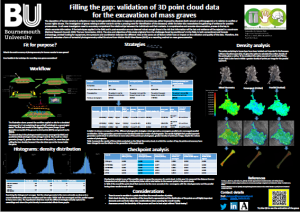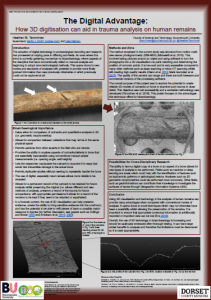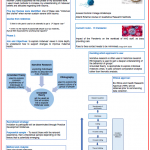The SciTech PGR Conference Committee are delighted to showcase the following virtual posters as part of the SciTech PGR Conference on the 9th October 2020:
Filling the gap: Validation of 3D point cloud data for the excavation and recording of mass graves
Samantha De Simone, Martin Smith, Andrew Ford, Ellen Hambleton, & Paul Cheetham
Click the image below to enlarge
 The application of digital technologies occupies a crucial role in the forensic arena, from the examination of injuries on a victim body and to capture a visual and spatial record of the crime scene. In order to obtain quality data, the analyses need to be performed with robust techniques, that must be able to meet the standard of accuracy, validity and reliably required in a courtroom. Among the novel technologies largely applied both during fieldwork and laboratory analyses is multi-view-stereo structure-from-motion (SfM-MVS) photogrammetry. SfM-MVS allows the generation of three-dimensional point (3D) cloud data from a set of overlapping photographs at different viewing angles, representing an accessible and affordable medium for forensic practitioners. Due to its accessibility and time effective aspect, SfM-MVS has been implemented as a recording tool in situ. Therefore, this study focuses on the validation of SfM-MVS for the recording the excavation and relationships of complex deposits in mass graves, where human remains may have high levels of fragmentation and commingling. The aim of the research is to reconstruct the entire excavation sequence in a single 3D point cloud. A complete sequence of the grave with point cloud data would serve as a permanent record and could fill the gap between experts working in the field and laboratory practitioners, enhancing the re-association of disarticulated and fragmented skeletons and facilitating the identification of individuals from their human remains.
The application of digital technologies occupies a crucial role in the forensic arena, from the examination of injuries on a victim body and to capture a visual and spatial record of the crime scene. In order to obtain quality data, the analyses need to be performed with robust techniques, that must be able to meet the standard of accuracy, validity and reliably required in a courtroom. Among the novel technologies largely applied both during fieldwork and laboratory analyses is multi-view-stereo structure-from-motion (SfM-MVS) photogrammetry. SfM-MVS allows the generation of three-dimensional point (3D) cloud data from a set of overlapping photographs at different viewing angles, representing an accessible and affordable medium for forensic practitioners. Due to its accessibility and time effective aspect, SfM-MVS has been implemented as a recording tool in situ. Therefore, this study focuses on the validation of SfM-MVS for the recording the excavation and relationships of complex deposits in mass graves, where human remains may have high levels of fragmentation and commingling. The aim of the research is to reconstruct the entire excavation sequence in a single 3D point cloud. A complete sequence of the grave with point cloud data would serve as a permanent record and could fill the gap between experts working in the field and laboratory practitioners, enhancing the re-association of disarticulated and fragmented skeletons and facilitating the identification of individuals from their human remains.
The digital advantage: How 3D digitisation can aid in trauma analysis on human remains
Heather Tamminen, Martin Smith, Kate Welham, & Andrew Ford
Click the image below to enlarge
 The benefits of recording cultural heritage through digital three-dimensional (3D) media are well-documented; the ability to analyse objects without damage, study items off-site, and compare remains that cannot otherwise be in the same vicinity are all important advantages. Increasingly, human remains are being digitised for respectful preservation and display, however a lot of work still needs to be done to test the quality of these models and their utility for detailed analysis. In 2009, construction of the Weymouth Relief Road led to the discovery of a mass burial with evidence for dramatic events occurring prior to their death. Dating from the 10th Century AD, the individuals were later identified as having originated in Scandinavia and North-Eastern Europe through their isotopic signatures. They had suffered widespread sharp force injuries and whilst these injuries were documented by conventional manual recording methods, more can be done to investigate them, especially with advances in technology. Due to the unique provenance of this collection, it was thought to be an ideal case study to investigate the potential of Multi-View Stereo Structure-from-Motion photogrammetry to generate 3D visualisations of injuries to skeletal remains which are of a quality high enough to study. Current results are promising and indicate that the models can provide detailed replications of the trauma that can be effectively studied without risk of damaging the specimens. The important question then remains of why this is something that researchers would want to spend time and energy doing when studying sharp force trauma. Therefore, this poster delves into the questions of why creating 3D models of sharp force trauma can help our understanding of past peoples and why this has the potential to be an excellent resource for individuals studying trauma both in archaeological and forensic situations.
The benefits of recording cultural heritage through digital three-dimensional (3D) media are well-documented; the ability to analyse objects without damage, study items off-site, and compare remains that cannot otherwise be in the same vicinity are all important advantages. Increasingly, human remains are being digitised for respectful preservation and display, however a lot of work still needs to be done to test the quality of these models and their utility for detailed analysis. In 2009, construction of the Weymouth Relief Road led to the discovery of a mass burial with evidence for dramatic events occurring prior to their death. Dating from the 10th Century AD, the individuals were later identified as having originated in Scandinavia and North-Eastern Europe through their isotopic signatures. They had suffered widespread sharp force injuries and whilst these injuries were documented by conventional manual recording methods, more can be done to investigate them, especially with advances in technology. Due to the unique provenance of this collection, it was thought to be an ideal case study to investigate the potential of Multi-View Stereo Structure-from-Motion photogrammetry to generate 3D visualisations of injuries to skeletal remains which are of a quality high enough to study. Current results are promising and indicate that the models can provide detailed replications of the trauma that can be effectively studied without risk of damaging the specimens. The important question then remains of why this is something that researchers would want to spend time and energy doing when studying sharp force trauma. Therefore, this poster delves into the questions of why creating 3D models of sharp force trauma can help our understanding of past peoples and why this has the potential to be an excellent resource for individuals studying trauma both in archaeological and forensic situations.
 PGR Virtual Poster Exhibition | Sara Stride
PGR Virtual Poster Exhibition | Sara Stride










 New Nepal scoping review on maternal & neonatal health
New Nepal scoping review on maternal & neonatal health Fourth INRC Symposium: From Clinical Applications to Neuro-Inspired Computation
Fourth INRC Symposium: From Clinical Applications to Neuro-Inspired Computation Writing policy briefs
Writing policy briefs Upholding Excellence: The Concordat to Support Research Integrity
Upholding Excellence: The Concordat to Support Research Integrity ECR Funding Open Call: Research Culture & Community Grant – Application Deadline Friday 12 December
ECR Funding Open Call: Research Culture & Community Grant – Application Deadline Friday 12 December MSCA Postdoctoral Fellowships 2025 Call
MSCA Postdoctoral Fellowships 2025 Call ERC Advanced Grant 2025 Webinar
ERC Advanced Grant 2025 Webinar Horizon Europe Work Programme 2025 Published
Horizon Europe Work Programme 2025 Published Horizon Europe 2025 Work Programme pre-Published
Horizon Europe 2025 Work Programme pre-Published Update on UKRO services
Update on UKRO services European research project exploring use of ‘virtual twins’ to better manage metabolic associated fatty liver disease
European research project exploring use of ‘virtual twins’ to better manage metabolic associated fatty liver disease